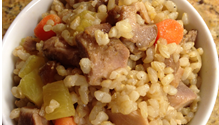By Bill Reddy, L.Ac., Dipl.Ac.

Sometimes the ancients know best. Traditional Asian medicine has been effectively used for thousands of years to fight illness, often relying on various herbs and foods to boost the body’s immune system or subdue unpleasant symptoms. That’s something to consider as the cold and flu season descends upon us. Maybe the next time you start sniffling or feel achy you should stop by the produce section before you head to the pharmacy for relief. We know your “medicine” will taste better; it might also work surprisingly well.
Here are some foods to consider:
Chicken Soup
Ah, yes, the first line of defense. Your mother, Jewish or Chinese or Thai, recommends it, and for good reason. Clinical studies demonstrate that ingredients in chicken soup reduce inflammation, easing symptoms related to upper respiratory tract infections. Nothing can simply “cure” a cold, but chicken soup does have a measurable therapeutic effect. Science isn’t sure exactly why that is, but studies have shown it’s not just the broth or its steam which produce an anti-inflammatory effect. There has to be both chicken and vegetables in the liquid to give it the magical power that moms the world over love. We recommend that you make your own chicken soup with fresh ingredients, but good commercially processed soups are also available which will do the trick.
Fresh Ginger Root
The Chinese have used ginger for over 2,500 years as a treatment for congestion, sinus pain and sore throats. The Chinese tradition says ginger contains potent yang energy for warming the stomach and lungs. Modern research backs that up, noting a warming effect and improvement in circulation and a stimulated immune system. Many users believe ginger is as good a painkiller as non-steroidal anti-inflammatory drugs such as ibuprofen. That’s because it restrains the body’s inflammatory reaction when a virus invades. It is that inflammation of mucus membranes, and the aches and pains which accompany it, which gives us unpleasant flu symptoms and fever. When used in tea, ginger helps a patient perspire, which aids in the elimination of toxins and speeds recovery.
We recommend crushing ginger root and brewing it as tea for at least five minutes. A little splash of lime or lemon will nicely accent the ginger (while adding some vitamin C).
Mushrooms
Traditional Chinese Medicine uses over 200 species of mushrooms, and many of them have immune- strengthening qualities. Among many healthful elements, mushrooms contain a substance called Germanium, which boosts oxygen efficiency in your body and increases its ability to fight disease. Mushrooms contain beta-glucans, which help repel colds. It is thought by some that the beta-glucans stimulate the immune system to destroy disease-causing cells.
We love Portobello, cremini and white button mushrooms, and here are some others you might wish to try:
Shiitake Mushrooms
One of the most popular mushrooms, the shiitake has been used by Asians for centuries as a stimulant to boost health, prevent strokes, and improve circulation. They’re excellent in many dishes, stir fries and soups, and can be found in many local supermarkets.
Reishi Mushrooms
Reishi mushrooms are routinely used in Chinese medicine because of their antibacterial, anti-inflammatory and immune-strengthening capabilities. They are also believed by some to slow cancer growth, produce a calming effect, and improve sleep. These mushrooms can be found at Asian supermarkets in the area.
Maitake Mushrooms
Maitake mushrooms are very popular in various Asian cultures for their ability to strengthen the immune function and improve general health. Researchers are exploring the possibility they may help fight tumors.
Garlic
Garlic is an immunity- enhancing food that goes with just about anything. A British study found that participants who took garlic extract pills were 66% less likely to catch a cold compared to those taking a placebo. But there’s even more good news: recent research demonstrates that people who consume more than 6 cloves a week have a 50% lower rate of stomach cancer and 30% lower rate of colorectal cancer. Garlic contains phytochemicals that fight bacteria and cholesterol. Garlic can be most effective if you peel and crush the cloves, or slice them, 15 minutes before you use them in cooking.
Onions
Much like garlic, onions have antimicrobial compounds which fight the flu. Naturally, raw onion will provide the strongest effect, but onions work so well in many foods that getting it into your system should not be a challenge.
Green Tea
Asians have been drinking it for centuries and we now know it contains antioxidants which can give a real boost to an immune system besieged by cold and flu viruses. People who drink green tea suffer fewer colds and flu, and their immune systems are also better equipped to fight viruses which might invade.
Black Tea
In a Harvard study, people who drank 5 cups of tea for two weeks had ten times more virus fighting interferon in their blood compared to those who drank a placebo. L-theanine, known to boost immune system function, is found in both black and green teas. Like green tea, black tea is full of polyphenols, which are antibacterial, antiviral and act as anti-inflammatories.
Tea is calorie free, but does contain caffeine, so be aware. It is thought that using milk might interfere with the body’s absorption of the health-aiding elements.
Honey
Go ahead and put honey in your tea; studies demonstrate that honey reduces coughing because it coats the throat and soothes soreness and itchiness. The effect is at least comparable to over-the-counter cough medicines, and tastes much better. Buckwheat honey is especially effective. (Remember: infants under one year old should not be given honey as there is a risk of infant botulism.)
Elderberry
Elderberry juice is a traditional cold-fighting drink. They may be a bit rare on area grocery shelves, but elderberries provide one of the highest concentrations of cold-fighting vitamin C in fruits. And, once again we find those phytochemicals which fight inflammation, viruses, and perhaps, as some believe, cancers. Elderberries can also be mixed with other fruits in food preparation, such as apple pie.
Cabbage
Cabbage is loaded with vitamin C, fiber and those friendly phytochemicals called glucosinolates we have referenced several times previously. Studies show cabbage has been effective in fighting viruses in animal tests.
Fish
Omega 3 fatty acids found in fish reduce inflammation and protect the lungs from colds and respiratory infection. These fatty acids, which increase airflow, are plentiful in mackerel, salmon and herring. Shellfish such as lobsters, crabs, clams and oysters are rich in selenium, helping white blood cells clear flu viruses out of your body. Two servings a week is recommended for adequate protection, unless you are pregnant, in which case you should take a break from fish for a while.
Carrots, Squash, and Sweet Potatoes
These vegetables are all rich in beta carotene, which helps keep skin healthy. When people think of their immune system, they tend not to think of their skin, but it is your largest organ, covering approximately 16 square feet, and serving as a first line defense against bacteria and viruses.
 Asian Fortune Your source for all things Asian American
Asian Fortune Your source for all things Asian American




Theanine has a chemical structure very similar to glutamate, a naturally occurring amino acid in the body that helps transmit nerve impulses in the brain. Some of the effects of theanine appear to be similar to glutamate, and some effects seem to block glutamate…,.’
Most interesting write-up on our internet page
<http://healthmedicine.co/